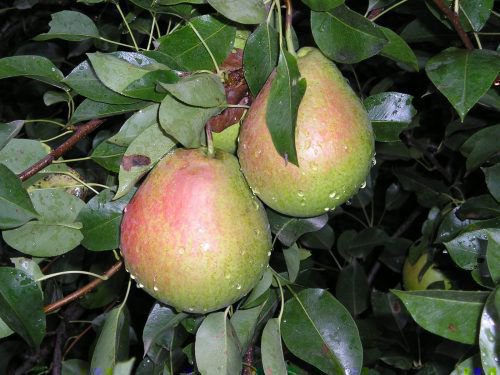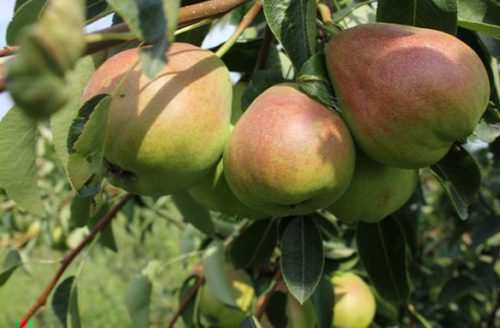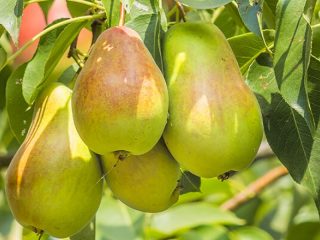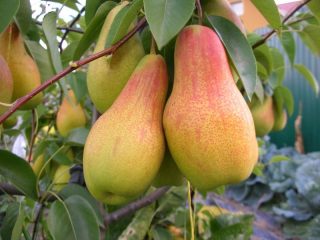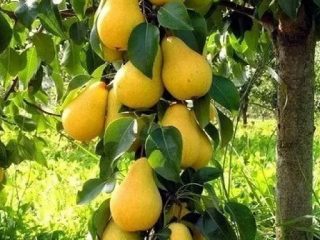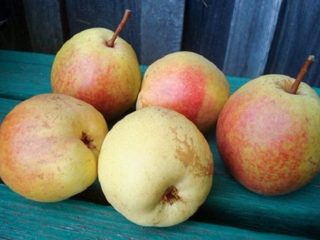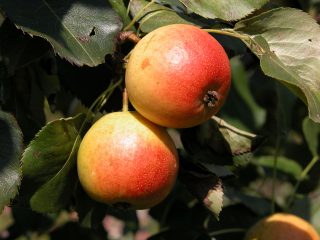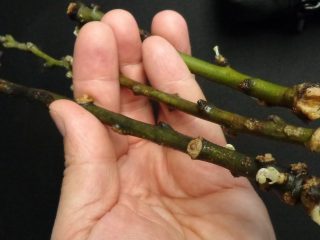Content
One of the most famous pear varieties in the country is the Tikhy Don hybrid. It is characterized by high productivity, unpretentious care, disease resistance. This is confirmed by the description, photos and reviews about the Tikhy Don pear.
Description of pear Quiet Don
Pear Tikhy Don is a hybrid from hybridization between varieties Rossoshanskaya beautiful and Marble. The variety was bred on the basis of the Rossoshanskaya zonal gardening station by the breeder A. M. Ulyanishcheva. The variety is included in the State Register in the Central Black Earth Region.
The plant is characterized by moderate growth, in 10 years it grows up to 3 m. Crohn of medium thickening, slightly weeping. It has a rounded shape. The stem is covered with gray bark, and the skeletal branches are gray-brown. They are placed in a tilt-upright position. A variety of fruit formation is annelid. Ringworms are placed on wood 2-3 years old, sessile.
Stems are erect, placed vertically, oblong. They are thickened and have a rounded cross-section. Their color is brownish-red. The internodes are medium, the number of shoots is low, without pubescence. Lentils are small, medium thickened. The buds are distinguished by a brownish color, protruding. The foliage of the Tikhiy Don pear is rich green, shiny, has an average size, stands out in an ovoid shape. On the edges of the leaves, there is a fine-toothed serration. The leaf blade is curved upward, leathery, no pubescence. The length and thickness of the leaf petiole are average.
The inflorescence is made in the form of an umbrella-shaped brush. Each of the inflorescences contains approximately 8 flowers. Flowers and buds have a deep white color, they have a cup-shaped shape. The petals are whole-edged, tightly closed together. The pistillate column is not pubescent, the stigma is placed on a par with the anthers.
Fruit characteristics
Fruits of impressive size ripen on the Tikhiy Don pear, the weight of which reaches 270 g. The maximum weight of ripe pears is 350 g. Fruits have a blunt-cone-shaped or oval shape. The peel is compacted. Upon reaching the stage of consumer maturity, the color of pears becomes yellowish-green, on which there is a pale blush of crimson-red color. Pears are densely covered with deep green subcutaneous spots. The peduncle is compacted and of medium size. There is usually no funnel, however, most often there is a slight influx near the stalk. The cup is half open or half closed. The saucer is folded, small, its width is average. The sub-cup tube of the Quiet Don pear is small. The seeds are oblong and brown in color.
The pulp of the ripe fruit is creamy-whitish, tender, oily, oozing heavily. The taste is excellent, rated by the tasters at 4.8 points. Reviews about pear Quiet Don confirms the assessment of her taste. It has a slight astringency and acidity. The commercial qualities of the fruit are at a high level.
Photos and descriptions confirm the positive qualities of the Tikhy Don pear variety.
Pros and cons of the Tikhiy Don pear variety
The benefits of the Tikhiy Don pear include:
- early maturity;
- large-fruited;
- scab immunity;
- compact size of the tree;
- high taste and marketability of fruits.
Optimal growing conditions
Pear variety Tikhiy Don takes root well in many regions. It is best to cultivate this hybrid in the Central Black Earth Region, however, subject to agricultural techniques, it can grow successfully in other areas, including those located in more northern latitudes.
The hybrid is characterized by a high degree of resistance to adverse environmental factors. Even in winters with temperatures down to -35C and below, the crust freezes by no more than 1.0 points. Due to spring frosts, which are observed during the flowering period, massive death of buds and flowers is possible. However, this also happened with most other varieties. Pear Quiet Don is drought-resistant. During the period of prolonged drought, no crushing of fruits or their mass abscission is observed.
Planting and caring for a pear Tikhiy Don
To grow the Tikhiy Don pear variety, it is necessary to plant the plants correctly. Subsequently, they need to be provided with quality care.
Landing rules
In order to plant the Tikhiy Don pear seedling correctly, you must act in accordance with the following algorithm:
- Before purchasing a seedling, it is important to thoroughly examine it externally. Preference should be given to those specimens that have a branching trunk. The optimum age of the seedling is 3 years. It is best to plant the Quiet Don pear in the autumn period, although planting is allowed to be postponed to spring.
- The place for cultivating a hybrid variety of pears Tikhiy Don should be spacious and accessible to the sun's rays. If possible, it should not be located in an elevated place. The pear has a positive attitude towards moisture that accumulates during the winter period in slightly low-lying areas.
- The plot begins to be prepared at the end of August. The soil is dug up and superphosphates, potassium salts, compost are added to it. Optionally, it is allowed to add humus.
- For a seedling, a planting hole is dug out a little more than the root system. A wooden stake is driven into the center of the pit, which should rise about 70-80 cm above ground level.
- Then a seedling is placed in the hole so that the root collar is 6 cm above the ground.
- Following this, the roots are straightened so that they, if possible, do not come into contact with each other, and they are covered with soil.
- After that, the seedling is tied to a peg with a twine, which is twisted into a figure eight.
- If several seedlings are planted at once, the distance between them is made equal to 7 m.
- A small ditch is dug around the planted seedling in a circle, which is needed for watering.
- Immediately after this, the Quiet Don pear is poured abundantly with warm, settled water.
- Several watering cans are poured under the plant one by one, waiting for the soil to settle. If necessary, you have to add earth.
- When watering is completed, the soil in the near-stem sector is mulched. This is to retain moisture and prevent growth. weeds.
Watering and feeding
Young pear seedlings Tikhiy Don require abundant irrigation, especially at 1 year of age. Water is introduced into a small ditch that was dug when planting the plant. This will not only make the irrigation procedure easier, but will also prevent root erosion.
Autumn fertilization for the Tikhy Don pear variety is carried out at the end of the harvest, when a third of the leaves on the tree have already turned yellow. Young seedlings are allowed not to be fed for 2 years if fertilizers were applied during soil preparation. In the fall, top dressing should not provoke secondary growth of shoots, therefore, the use of nitrogen-containing elements is excluded. 2 tbsp. l. superphosphate and 1 tbsp. l.potassium chloride is diluted in a 10-liter container with water, mixed thoroughly and watered with the resulting plantation solution.
Several dressings are carried out in the spring. The first of them, which is aimed at activating the development of young shoots, is carried out with the help of saltpeter, carbamide, chicken manure and other nitrogen fertilizers.
When flowering begins, the pear is fed with nutrients that ensure high quality fruit. In this case, the best option is nitroammophoska. During the ovary of the harvest, the Tikhy Don variety is fed with phosphorus-potassium fertilizers.
Pruning
The formation of the crown of a pear Tikhiy Don begins after a year and a half from the moment of planting the seedling. The procedure is carried out in the spring. The plant is pruned at a level of 0.5 m from the ground. This will provide improved development of the crown and downstream branches. On 2-year-old seedlings, it is recommended to shorten the disturbing, upright growing shoots.
Whitewash
The trunk of the Quiet Don pear must be whitewashed in order to facilitate the exit of the plant from the state of winter dormancy. Whitewashing can be purchased in a store or you can do it yourself. In the latter case, it is necessary to dilute 1.5 kg of clay and 2 kg of lime in a bucket of water. They begin to whitewash the plant from the lower skeletal branches to ground level. Young seedlings are allowed to whiten completely.
Preparing for winter
Before the beginning of winter, the soil in the near-trunk sector is dug up and spilled with water. After that, the soil is covered with humus with the addition of peat or sawdust. The thickness of the layer should be approximately 20 cm, which provides reliable protection for the root system of the Tikhiy Don pear.
For better wintering of the plant, it is recommended to cover it with snow. It has a positive effect on the condition of the root system. Snow provides the roots with moisture and protects them from freezing.
Pollination
Pear variety Tikhiy Don is self-fertile. In order for the pollination of the hybrid to be successful, it is required to plant the varieties Dessertnaya Rossoshanskaya and Mramornaya next to it. Some other varieties are also suitable, the flowering period of which coincides with that of the Quiet Don pear.
Yield
The advantage of the Quiet Don pear is its high productivity. The variety begins to bear fruit relatively early - 3 years after planting.
Every year more and more fruits are harvested from the plant. In 1 year of cultivation, 20 kg of the crop are harvested, and in 10 year - about 70 kg. Pears do not crumble and do not shrink, which greatly facilitates their harvesting. The harvest begins in the second decade of September and continues until the end of autumn.
Diseases and pests
Pear Quiet Don is relatively resistant to disease, however, it can be affected by septoria. This disease manifests itself in the last May decade. To prevent the disease, the plantings are treated with "Nitrafen" (300 g / 10 l of water) before the budding begins.
Plants can be damaged by rodents. The lower part of the trunk is wrapped with thick paper in several layers to prevent this.
Reviews about pear Tikhiy Don
Conclusion
Description, photos and reviews about the Quiet Don pear confirm its quality. The variety is the best option for those gardeners who want to grow compact pear plants in their garden.
